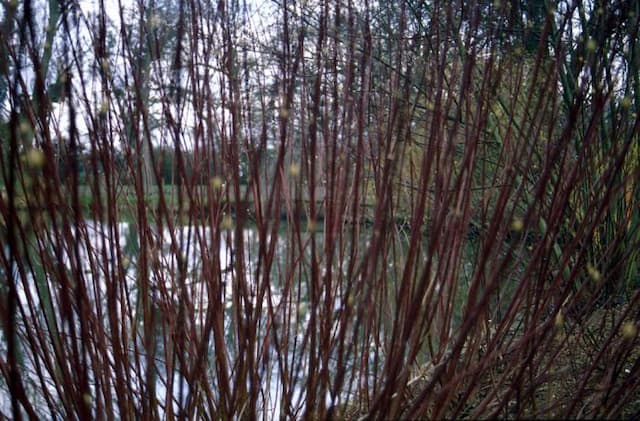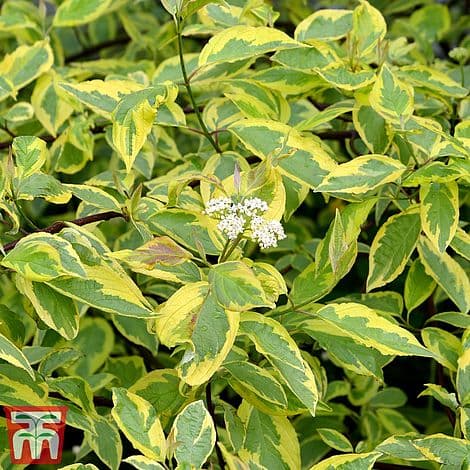Flowering Dogwood Cornus 'Porlock'

ABOUT
Cornus 'Porlock', commonly known as a variety of flowering dogwood, exhibits a robust and ornamental appearance that captivates the eye throughout the seasons. This attractive deciduous shrub or small tree boasts a multi-stemmed and rounded habit that contributes to its bushy look. Its leaves are ovate and come out with a bright green color, providing a lush backdrop for its most striking feature—its blooms. The flowers of Cornus 'Porlock' are not the small, inconspicuous yellowish center flowers one might expect; rather, the real showstoppers are the large, showy petal-like bracts that surround the cluster of true flowers. These bracts are most commonly white, but can show tinges of pink, especially as they age. Each bract is broad with a tapered point, and when they bloom in spring, the floral display is simply stunning, enveloping the plant in a cloud of radiance. After the flowering season, the plant produces berry-like fruits that add yet another layer of interest. These are typically a bold blue or blue-black color and will often attract birds and wildlife to the garden. Moreover, the foliage undergoes a captivating transformation come autumn, with leaves changing hues to display a medley of reds and purples before they ultimately drop. Throughout the year, the textured bark on the mature stems provides yet another decorative element. The bark has a mottled appearance with flakes of gray and brown, making the Cornus 'Porlock' a continual source of natural beauty, regardless of the season.
About this plant
 Names
NamesFamily
Cornaceae
Synonyms
Wedding Cake Tree, Giant Dogwood, Cornus Controversa Variegata
Common names
Cornus 'Porlock'.
 Toxicity
ToxicityTo humans
The Cornus 'Porlock', commonly known as a variety of dogwood, is generally not considered toxic to humans. However, while not highly poisonous, consuming parts of the dogwood like leaves or bark may cause mild gastrointestinal upset in some individuals. Symptoms might include nausea, vomiting, or diarrhea if ingested. It is recommended to avoid consuming any parts of the plant, as the compounds within are not meant for human consumption.
To pets
The Cornus 'Porlock', commonly known as a variety of dogwood, is not typically considered to be highly toxic to pets. However, ingestion of parts of this plant can sometimes cause mild gastrointestinal upset in animals. If a pet were to ingest significant quantities of dogwood leaves or stems, it might experience symptoms such as vomiting or diarrhea. As with most ornamental plants, it is advisable to keep an eye on your pet and prevent them from chewing on the plant for their safety.
 Characteristics
CharacteristicsLife cycle
Perennials
Foliage type
Deciduous
Color of leaves
Green
Flower color
White
Height
6-8 feet (1.8-2.4 meters)
Spread
6-8 feet (1.8-2.4 meters)
Plant type
Shrub
Hardiness zones
7
Native area
Asia
Benefits
 General Benefits
General Benefits- Ornamental Value: Offers striking blooms in the spring that enhance the aesthetic appeal of any garden or landscape.
- Attracts Wildlife: Attracts pollinators like bees and butterflies, promoting a healthy ecosystem.
- Seasonal Interest: Provides year-round interest with flowers in spring, fruit in late summer or fall, and colorful foliage in autumn.
- Low Maintenance: Requires minimal care once established, suited for gardeners of all skill levels.
- Drought Tolerance: Can withstand periods of low water, making it suitable for xeriscaping or areas with water restrictions.
- Cold Hardy: Adapts well to colder climates, increasing its versatility in different garden zones.
- Erosion Control: With its dense growth habit, it can help stabilize slopes and prevent soil erosion.
- Habitat Shelter: Offers shelter for birds and other wildlife, creating a mini refuge within the landscape.
 Medical Properties
Medical PropertiesThis plant is not used for medical purposes.
 Air-purifying Qualities
Air-purifying QualitiesThis plant is not specifically known for air purifying qualities.
 Other Uses
Other Uses- The Cornus 'Porlock', often known as dogwood, can be used in photography and painting as a subject for its striking floral bracts and autumn foliage, providing a vivid and attractive element to artistic compositions.
- Dogwood branches can be used in basketry; their flexible stems allow for weaving into intricate patterns, creating strong and decorative baskets.
- The dense foliage and robust form of dogwood can provide natural fencing or living screens for privacy in gardens and landscapes.
- Dogwood can be employed in bird gardens as the plant attracts wildlife, offering shelter and producing berries that serve as a food source for various bird species.
- Its wood is prized for its density and durability, often used for making small turned objects such as tool handles or knitting needles within the craft industry.
- The fall coloration of dogwood leaves can be used as a natural dye; the varying shades of red, orange, and purple offer potential for fabric and yarn dyeing.
- Stems of red or yellow twig dogwood are often utilized in floral arrangements, especially during the winter months when their brightly colored branches add contrast to the arrangements.
- For educational purposes, dogwood can be used in botanical studies to teach about plant taxonomy and identification due to its characteristic flowering pattern and leaf morphology.
- The strong structural presence of dogwood can be harnessed in landscape design to enhance architectural features by contrasting the vertical lines of structures.
- In ecological restoration projects, dogwood can serve as an important plant species for stabilizing stream banks and preventing soil erosion due to its root system.
Interesting Facts
 Feng Shui
Feng ShuiThe Dogwood is not used in Feng Shui practice.
 Zodiac Sign Compitability
Zodiac Sign CompitabilityThe Dogwood is not used in astrology practice.
 Plant Symbolism
Plant Symbolism- Resilience and Durability: The Cornus 'Porlock', commonly known as the Flowering Dogwood, is renowned for its tough wood and ability to withstand various conditions, symbolizing strength and the ability to endure challenges.
- Purity and Innocence: Flowering Dogwoods are often associated with their pristine white blossoms, conveying a sense of purity and innocence.
- Christian Symbolism: In Christian symbolism, the Flowering Dogwood is said to represent the crucifixion of Christ, with the cross-shaped flowers and red berries symbolizing Christ's blood.
- Rebirth and Renewal: As the Flowering Dogwood blooms in spring, it is often seen as a symbol of new beginnings and the rejuvenation of nature.
 Water
WaterFor the Cornus 'Porlock', commonly known as the Strawberry Tree, it is important to maintain consistent moisture, especially during the first few years after planting and during dry spells. Water the tree deeply once a week, providing about 1 to 1.5 gallons per watering session for young trees. Adjust the amount as the tree matures, aiming for the equivalent of 1 inch of rainfall per week. During the hotter summer months, you may need to increase the frequency to twice a week if there isn't sufficient rainfall. Make sure to water at the base of the tree, avoiding overhead watering to prevent fungal diseases.
 Light
LightThe Strawberry Tree thrives in full sun to partial shade conditions. It is best positioned in a location that receives at least four to six hours of direct sunlight each day. Avoid deep shade locations, as insufficient light can affect the plant's flowering and overall vigor. The ideal spot would be one that offers morning sunlight and some afternoon shade, especially in areas with hot summers.
 Temperature
TemperatureThe Strawberry Tree, or Cornus 'Porlock', prefers moderate temperatures and can handle a range from about 20°F to 85°F. It is hardy in USDA zones 7 to 9, indicating that it can survive winter conditions as low as 0°F. However, its ideal temperature range for optimal growth and flowering would be between 60°F and 75°F. Ensure it is planted in a location where it is protected from harsh winter winds or extreme summer heat.
 Pruning
PruningPruning the Strawberry Tree is necessary to maintain its shape, encourage healthy growth, and remove any damaged or diseased branches. It is best pruned in late winter or early spring before new growth begins. Prune sparingly, removing only what is necessary, and make clean cuts just above a bud facing the outside of the tree to encourage outward growth. If the tree is well-established, an annual light pruning to shape and thin the branches is usually all that is required.
 Cleaning
CleaningAs needed
 Soil
SoilThe Cornus 'Porlock', commonly known as the 'Porlock' flowering dogwood, thrives in a well-drained, loamy soil with a pH of 5.5 to 6.5. The best soil mix should contain equal parts of garden soil, compost, and peat or leaf mold to maintain moisture and fertility. Mulching is beneficial to retain soil moisture and keep roots cool.
 Repotting
RepottingThe 'Porlock' flowering dogwood is typically planted outdoors and does not require frequent repotting. In the case of container-grown plants, repotting should be done every 2-3 years in the spring, when it outgrows its current pot or when the soil is depleted.
 Humidity & Misting
Humidity & MistingThe 'Porlock' flowering dogwood prefers moderate humidity levels. Maintaining the humidity around 50-60% is ideal for this plant. While it tolerates a range of humidity levels, providing consistent moderate humidity will keep the foliage healthy and prevent stress.
 Suitable locations
Suitable locationsIndoor
Ensure bright indirect light and keep away from dry heat sources.
Outdoor
Plant in partial shade, sheltered from strong winds.
Hardiness zone
6-9 USDA
 Life cycle
Life cycleCornus 'Porlock', commonly known as the Porlock flowering dogwood, begins its life as a seed, which after stratification, germinates in spring. Upon germination, the seedling emerges and grows into a young plant, with the development of roots and shoots that will form the basis of the mature tree. As the dogwood matures, it develops a woody stem and branches, along with characteristic oval-shaped leaves. The Porlock flowering dogwood reaches reproductive maturity after several years, showcasing its hallmark feature of bracted blooms, which are typically white or pink, followed by berry-like fruits. These fruits are then dispersed, often by birds, to propagate the next generation of plants. The dogwood, as a perennial woody plant, will go through a period of dormancy during the winter months, only to begin a new growth cycle with the return of warmer spring temperatures.
 Propogation
PropogationPropogation time
Spring-Early Summer
The Cornus 'Porlock', commonly known as a hybrid variety of the flowering dogwood, is most successfully propagated using softwood cuttings during late spring to early summer when the plant is actively growing. This method involves taking cuttings from new growth that is not yet hard, typically 4 to 6 inches (about 10 to 15 cm) long, ensuring each cutting has several leaves. The lower leaves are removed, and the cut end is dipped in rooting hormone to encourage root development. Afterward, the cuttings are planted in a well-draining soil mix and kept in a humid environment with indirect light until they root, which usually takes a few weeks. Once the cuttings have established a good root system, they can be transplanted to their final location.









